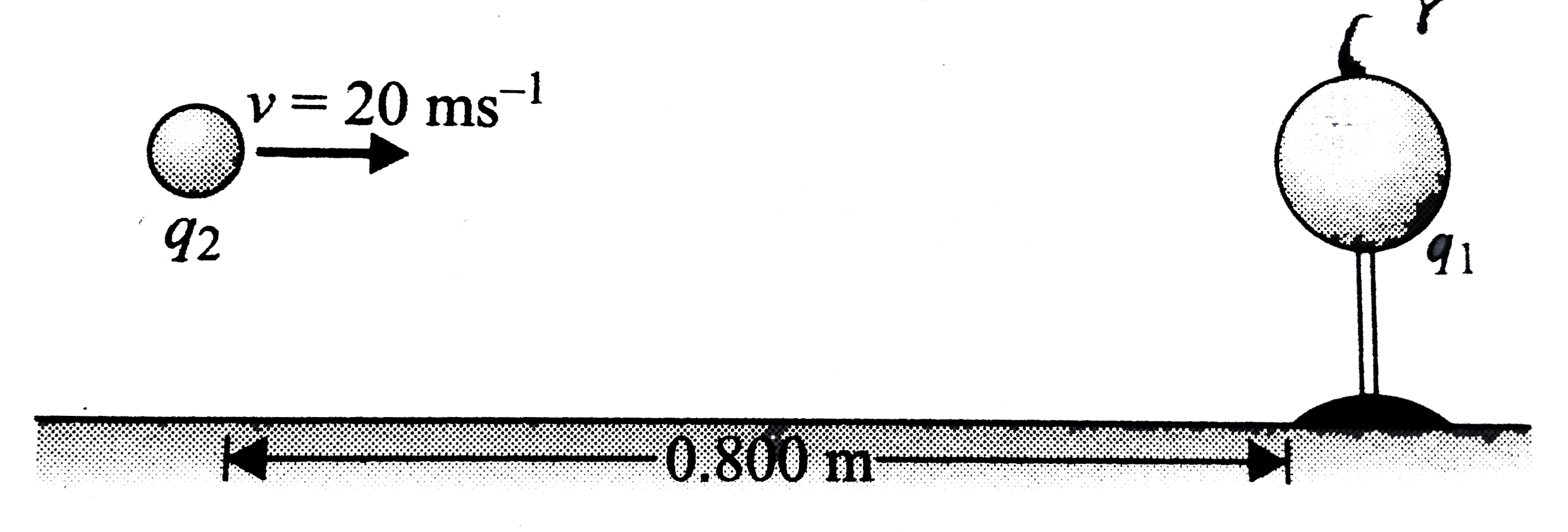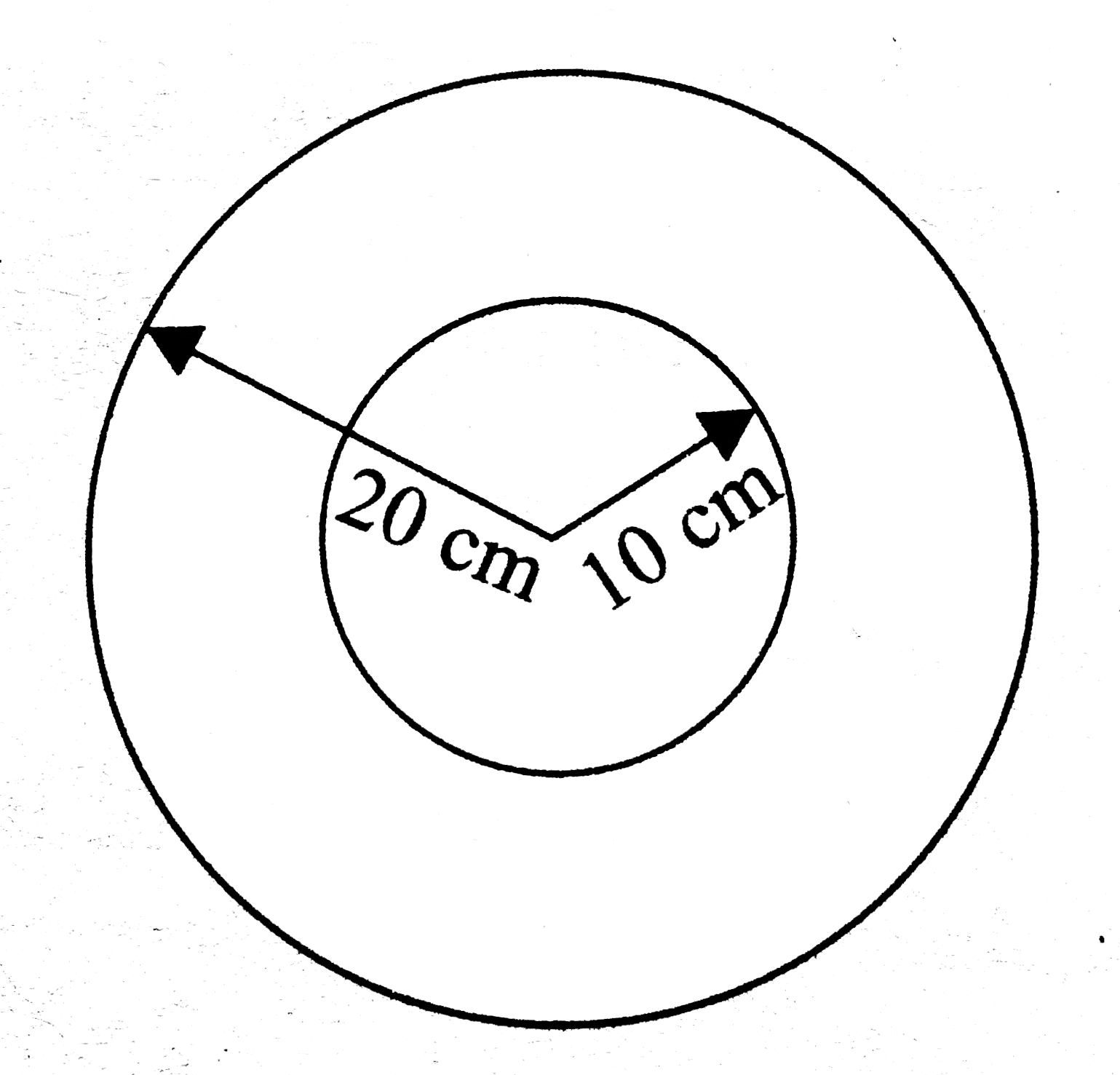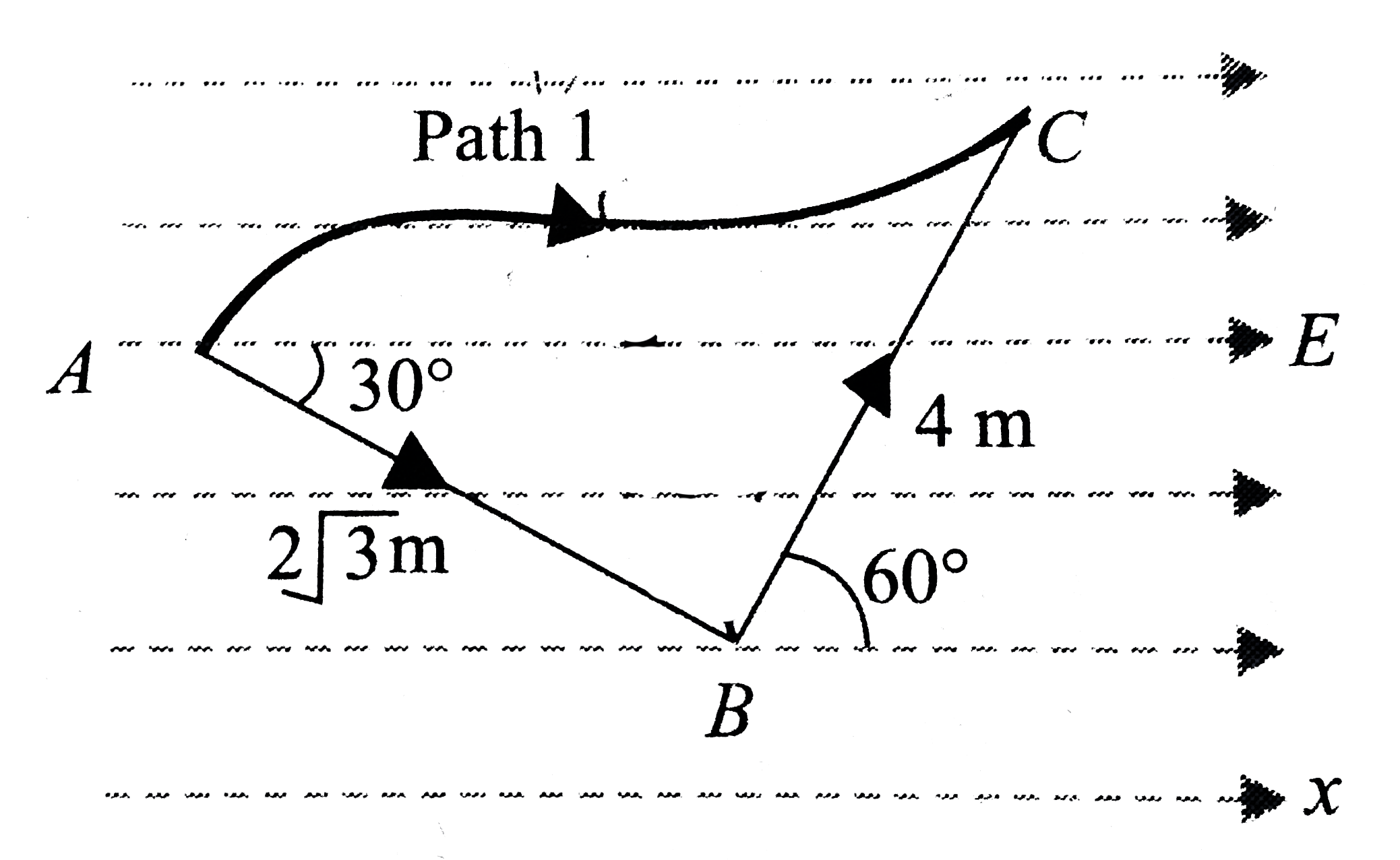Complete Solutions to Comprehension of chapter ELECTRIC POTENTIAL of Class 12 book with complete answers and questions
| Class 12 | PHYSICS |
| Chapter | ELECTRIC POTENTIAL |
| CENGAGE PHYSICS | Comprehension |
| Number Of Questions | 31 |
| Academic Year | 2023-24 |
Two point charges are located on the x - axis : `q_1 = -e` at `x = 0` and `q_2 = + e` at `x = a`.
The work done by an external force to bring a third point charge `q_3 = +e` from infinity to `x = 2a` is.
View SolutionTwo point charges are located on the x - axis : `q_1 = -e` at `x = 0` and `q_2 = + e` at `x = a` and `q_3 = + e` at `x = 2a`.
The total potential energy of the system of three charges.
View SolutionA small metal sphere, carrying a net charge `q_1 = -2 mu C`, is held in a stationary position by insulating supports. A second small metal sphere, with a net charge of `q_2 = -8 mu C` and mass `1.50 g`, is projected toward `q_1`. When the two spheres are `0.800 m` apart, `q_2` is moving toward `q_1` with speed `20 ms^-1` as shown in (Fig. 3.151). Assume that the two spheres can be treated as point charges. You can ignore the force of gravity.
 .
.
The speed of `q_2` when the spheres are `0.400 m` apart is.
View SolutionA small metal sphere, carrying a net charge `q_1 = -2 mu C`, is held in a stationary position by insulating supports. A second small metal sphere, with a net charge of `q_2 = -8 mu C` and mass `1.50 g`, is projected toward `q_1`. When the two spheres are `0.800 m` apart, `q_2` is moving toward `q_1` with speed `20 ms^-1` as shown in (Fig. 3.151). Assume that the two spheres can be treated as point charges. You can ignore the force of gravity.
 .
.
How close does `q_2` get to `q_1` ?
View SolutionFour charges `+q, +q, -q, and -q` are placed, respectively, at the corners `A,B,C, and D` of a square of side `a`, arranged in the given order. `E and F` are the midpoints of sides `BC and CD`, respectively, `O` is the center of square.
The electric field at `O` is.
View SolutionFour charges `+q, +q, -q, and -q` are placed, respectively, at the corners `A,B,C, and D` of a square of side `a`, arranged in the given order. `E and F` are the midpoints of sides `BC and CD`, respectively, `O` is the center of square.
The electric potential at `O` is.
View SolutionFour charges `+q, +q, -q, and -q` are placed, respectively, at the corners `A,B,C, and D` of a square of side `a`, arranged in the given order. `E and F` are the midpoints of sides `BC and CD`, respectively, `O` is the center of square.
The work done in carrying a charge `e` from `O` to E is.
View SolutionFour charges `+q, +q, -q, and -q` are placed, respectively, at the corners `A,B,C, and D` of a square of side `a`, arranged in the given order. `E and F` are the midpoints of sides `BC and CD`, respectively, `O` is the center of square.
The work done in carrying a charge `e` from `O` to `F` is.
View SolutionA charge 'Q' is distributed over two concentric hollow spheres of radii 'r' and 'R' `(gtr)` such that the surface densities are equal. Find the potential at the common centre.
View SolutionA charge Q is distributed over two concentric hollow spheres of radii r and `R (gt r)` such that the surface charge densities are equal. Find the potential at the common centre.
View SolutionThe electrical potential function for an electrical field directed parallel to the x-axis is shown in the given graph.
 Draw the graph of electric field strength.
Draw the graph of electric field strength.
View SolutionThe electrical potential function for an electrical field directed parallel to the x - axis is shown in (Fig. 3.152).
 .
.
The magnitude of the electric field in the x - direction in the interval `4 le x le 8` is
View SolutionThe electrical potential function for an electrical field directed parallel to the x-axis is shown in the given graph.
 Draw the graph of electric field strength.
Draw the graph of electric field strength.
View SolutionA uniform electric field of `100 Vm^-1` is directed at `30^(@)` with the positive x - axis as shown in (Fig. 3.153). `O A = 2 m` and `O B = 4 m`.
 .
.
The potential difference `V_O - V_A` is.
View SolutionA uniform electric field of `100 Vm^-1` is directed at `30^(@)` with the positive x - axis as shown in (Fig. 3.153). `O A = 2 m` and `O B = 4 m`.
 .
.
The potential difference `V_B - V_A` is.
View SolutionThe electric potential varies in space according to the relation `V = 3 x + 4 y`. A particle of mass `0.1 kg` starts from rest from point `(2,3.2)` under the influence of this field. The charge on the particle is `+1 mu C`. Assume `V` and (x,y) are in `S I` units.
The component of electric field in the x - direction `(E_x)` is.
View SolutionThe electric potential varies in space according to the relation `V = 3 x + 4 y`. A particle of mass `0.1 kg` starts from rest from point `(2,3.2)` under the influence of this field. The charge on the particle is `+1 mu C`. Assume `V` and (x,y) are in `S I` units.
The component of electric field in the y - direction `(E_y)` is.
View SolutionThe electric potential varies in space according to the relation `V = 3 x + 4 y`. A particle of mass `0.1 kg` starts from rest from point `(2,3.2)` under the influence of this field. The charge on the particle is `+1 mu C`. Assume `V` and (x,y) are in `S I` units.
The time taken to cross the x - axis is.
View SolutionThe electric potential varies in space according to the relation `V = 3 x + 4 y`. A particle of mass `0.1 kg` starts from rest from point `(2,3.2)` under the influence of this field. The charge on the particle is `+1 mu C`. Assume `V` and (x,y) are in `S I` units.
The velocity of the particle when it crosses the x - axis is
View SolutionThree concentric spherical metallic shells `A, B, and C` of radii `a,b, and c(a lt b lt c)` have surface charge densities `sigma, -sigma` and `sigma`, respectively.
If `V_(A), V_(B)` and `V_(C)` are potential of shells A, B and C, respectively, match the columns
`{:("Column A",,,"Column B"),(a. V_(A),,i.,sigma/epsilon_(0)[(a^(2)-b^(2)+c^(2))/c]),(b. V_(B),,ii.,sigma^(2)/epsilon_(0)[a^(2)/b-b+c]),(c. V_(C),,iii.,sigma/epsilon_(0)[a-b+c]):}`
View SolutionThree concentric spherical metallic shells A, B and C of radii a, b and c (a lt b ltc) have surface charge densities `sigma`, `-sigma` and `sigma` respectively. If the shells A and C are at the same potential, obtain the relation between the radii a, b and c.
View SolutionWe have an isolated conducting spherical shell of radius `10 cm`. Some positive charge is given to it so that the resulting electric field has a maximum intensity of `1.8 xx 10^6 NC^-1`. The same amount of negative charge is given to another isolated conducting spherical shell of radius `20 cm`. Now, the first shell is placed inside the second so that both are concentric as shown in (Fig. 3.154).
 .
.
The electric potential at any point inside the first shell is.
View SolutionWe have an isolated conducting spherical shell of radius `10 cm`. Some positive charge is given to it so that the resulting electric field has a maximum intensity of `1.8 xx 10^6 NC^-1`. The same amount of negative charge is given to another isolated conducting spherical shell of radius `20 cm`. Now, the first shell is placed inside the second so that both are concentric as shown in (Fig. 3.154).
 .
.
The electric field intensity just inside the outer sphere.
View SolutionWe have an isolated conducting spherical shell of radius `10 cm`. Some positive charge is given to it so that the resulting electric field has a maximum intensity of `1.8 xx 10^6 NC^-1`. The same amount of negative charge is given to another isolated conducting spherical shell of radius `20 cm`. Now, the first shell is placed inside the second so that both are concentric as shown in (Fig. 3.154).
 .
.
The electrostatic energy stored in the system is.
View SolutionWe have an isolated conducting spherical shell of radius `10 cm`. Some positive charge is given to it so that the resulting electric field has a maximum intensity of `1.8 xx 10^6 NC^-1`. The same amount of negative charge is given to another isolated conducting spherical shell of radius `20 cm`. Now, the first shell is placed inside the second so that both are concentric as shown in (Fig. 3.154).
 .
.
If both the spheres are connected by a conducting wire, then.
View SolutionIn a certain region, electric field `E` exists along the x - axis which is uniform. Given `B = 2 sqrt(3) m` and `BC = 4 m`. Points A, B, and C are in `x y` plane.
 .
.
Find the potential difference `V_A - V_B` between the points `A and B`.
View SolutionIn a certain region, electric field `E` exists along the x - axis which is uniform. Given `B = 2 sqrt(3) m` and `BC = 4 m`. Points A, B, and C are in `x y` plane.
 .
.
find the potential difference `V_C - V_B` between the points `C and B`.
View SolutionIn a certain region, electric field `E` exists along the x - axis which is uniform. Given `B = 2 sqrt(3) m` and `BC = 4 m`. Points A, B, and C are in `x y` plane.
 .
.
A charged particle `q` is moved from A to C as shown in path `1`. What is the work done by electric field in this process ?
View SolutionAn uniform electric field of strength `E` exists in a region. An electron of mass `m` enters a point A perpendicular to x - axis with velocity `V`. It moves through the electric field and exists at point `B`. The components of velocity at `B` are shown in (Fig. 3.156). At `B` the y - component of velocity remain uncharged.
 .
.
Find electric field.
View SolutionAn uniform electric field of strength `E` exists in a region. An electron of mass `m` enters a point A perpendicular to x - axis with velocity `V`. It moves through the electric field and exists at point `B`. The components of velocity at `B` are shown in (Fig. 3.156). At `B` the y - component of velocity remain uncharged.
 .
.
Find velocity at `B`.
View SolutionAn uniform electric field of strength `E` exists in a region. An electron of mass `m` enters a point A perpendicular to x - axis with velocity `V`. It moves through the electric field and exists at point `B`. The components of velocity at `B` are shown in (Fig. 3.156). At `B` the y - component of velocity remain uncharged.

Find the rate of work done by the field at `B`.
View Solution
Comprehension questions and complete solutions for chapter ELECTRIC POTENTIAL of CENGAGE PHYSICS (HINGLISH) of Class 12